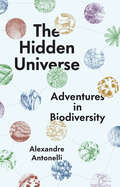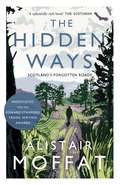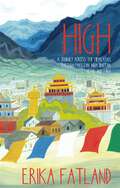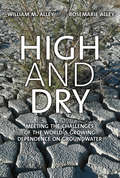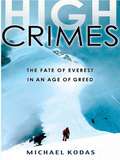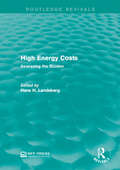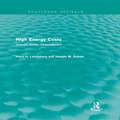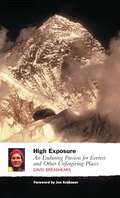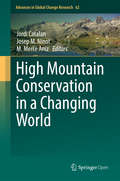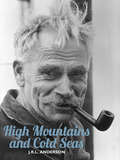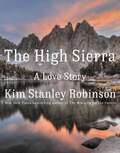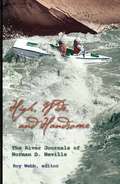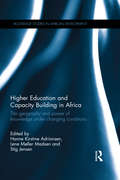- Table View
- List View
The Hidden Universe: Adventures in Biodiversity
by Alexandre AntonelliAn unforgettable exploration of the natural world and the concept of biodiversity—what it is, why it matters, and how we as individuals can work to preserve it. We are now living in an environmental emergency. As climate change, habitat loss, and other threats have placed almost one-fifth of all species on Earth at risk of extinction in the coming decades, a deeper understanding of biodiversity has never been more important. Biodiversity encompasses the rich variety of all life on Earth—the building blocks of life that provide invaluable sources of food, medicine, clothing, building materials, and more. Marking the arrival of a bold new voice in popular science, The Hidden Universe shows readers what’s at stake in the fight to protect and restore biodiversity, but also what can and should be done now to protect our planet and ourselves for the future. As director of science at one of the world’s largest research organizations in plant and fungal sciences, Brazilian-born scientist Alexandre Antonelli is ideally suited to reveal the wonders of biodiversity at a genetic, species, and ecosystem level—what biodiversity is, how it works, and why it is the most important tool in our battle against climate change. Antonelli offers recommendations for large-scale political changes, as well as smaller, practical steps that readers can implement in their own lives and homes. With Antonelli as our guide, The Hidden Universe helps us imagine a future where biodiversity is not just preserved but cherished.
The Hidden Ways: Scotland's Forgotten Roads
by Alistair MoffatShortlisted for the Edward Stanford Travel Writing Awards In The Hidden Ways, Alistair Moffat traverses the lost paths of Scotland. Down Roman roads tramped by armies, warpaths and pilgrim routes, drove roads and rail roads, turnpikes and sea roads, he traces the arteries through which our nation's lifeblood has flowed in a bid to understand how our history has left its mark upon our landscape. Moffat's travels along the hidden ways reveal not only the searing beauty and magic of the Scottish landscape, but open up a different sort of history, a new way of understanding our past by walking in the footsteps of our ancestors. In retracing the forgotten paths, he charts a powerful, surprising and moving history of Scotland through the unremembered lives who have moved through it.
The Hidden World: How Insects Sustain Life on Earth Today and Will Shape Our Lives Tomorrow
by George McGavinInsects conquered the Earth long before we did and will remain here long after we're gone.They outnumber us in the billions and are essential to many of the natural processes that keep us alive and that we take for granted.Yet, despite this, very few of us know much about the hidden world of insects.In this fascinating new book, entomologist and broadcaster George McGavin takes a deep dive to reveal the unknown truths about the most successful and enduring animal group the world has ever seen, and to show the unseen effects this vast population has on our planet, if only we care to look.McGavin explores not only the incredible traits that insects have evolved to possess, such as dragonflies that can fly across oceans without resting or beetles that lay their eggs exclusively in corpses, but also the vital lessons we have learnt from them, including how therapy using maggots can save lives and how bees can help grow rich tomato yields.The Hidden World reveals the wonderful complexity of our relationship with insects, how they have changed the course of our history and how, if we continue to learn from them, they could even be the key to our future and survival.
High: A Journey Across the Himalayas Through Pakistan, India, Bhutan, Nepal and China
by Erika Fatland"Enchanting" Independent"Fatland is a sensitive and insightful chronicler of quotidian lives and a compelling narrator" Observer"Erika Fatland ascends to new heights with her fascinating journey" WanderlustAn ambitious and magnificent new travelogue by internationally bestselling, prizewinning writer Erika Fatland.The Himalayas meander for more than two thousand kilometres through many different countries, from Pakistan to Myanmar via Nepal, India, Tibet and Bhutan, where the world religions of Islam, Buddhism and Hinduism are interspersed with ancient shamanic beliefs. Countless languages and vastly different cultures exist in these isolated mountain valleys. Modernity and tradition collide, while the great powers fight for influence.We have read about climbers and adventurers on their way up Mount Everest, and about travellers on a spiritual quest to remote Buddhist monasteries. Here, however, the focus is on the communities of these Himalayan valleys, those who live and work in this extraordinary region. As Erika Fatland introduces us to the people she meets along her journey, and in particular the women, she takes us on a vivid and dizzying expedition at altitude through incredible landscapes and dramatic, unknown histories. Skilfully weaving together the politics, geography, astrology, theology and ecology of this vast region, she also explores some of the most volatile human conflicts of our times.With her unique gift for listening, and for storytelling, she has become one of the most exciting travel writers of her generation.Translated from the Norwegian by Kari Dickson
High Altitude Primates (Developments in Primatology: Progress and Prospects #44)
by Nanda B. Grow Sharon Gursky-Doyen Alicia KrztonThe basic goal of the volume is to compile the most up to date research on how high altitude affects the behavior, ecology, evolution and conservation status of primates, especially in comparison to lowland populations. Historically, the majority of primate studies have focused on lowland populations. However, as the lowlands have been disappearing, more and more primatologists have begun studying populations located in higher altitudes. High altitude populations are important not only because of their uniqueness, but also because they highlight the range of primate adaptability and the complex variables that are involved in primate evolution. These populations are good examples of how geographic scales result in diversification and/or speciation. Yet, there have been very few papers addressing how this high altitude environment affects the behavior, ecology, and conservation status of these primates.
High and Dry: Meeting the Challenges of the World's Growing Dependence on Groundwater
by William M. Alley Rosemarie AlleyAn engaging call to understand and protect groundwater, the primary source of drinking water for almost half of the world’s population Groundwater is essential for drinking water and food security. It provides enormous environmental benefits by keeping streams and rivers flowing. But a growing global population, widespread use of industrial chemicals, and climate change threaten this vital resource. Groundwater depletion and contamination has spread from isolated areas to many countries throughout the world. In this accessible and timely book, hydrology expert William M. Alley and science writer Rosemarie Alley sound the call to protect groundwater. Drawing on examples from around the world, including case studies in the United States, Canada, Australia, India, and Sub-Saharan Africa, the authors examine groundwater from key scientific and socioeconomic perspectives. While addressing the serious nature of groundwater problems, the book includes stories of people who are making a difference in protecting this critical resource.
High Crimes: The Fate of Everest in an Age of Greed
by Michael KodasHigh Crimes is journalist Michael Kodas's gripping account of life on top of the world--where man is every bit as deadly as Mother Nature. In the years following the publication of Into Thin Air, much has changed on Mount Everest. Among all the books documenting the glorious adventures in mountains around the world, none details how the recent infusion of wealthy climbers is drawing crime to the highest place on the planet. The change is caused both by a tremendous boom in traffic, and a new class of parasitic and predatory adventurer. It's likely that Jon Krakauer would not recognize the camps that he visited on Mount Everest almost a decade ago. This book takes readers on a harrowing tour of the criminal underworld on the slopes of the world's most majestic mountain.High Crimes describes two major expeditions: the tragic story of Nils Antezana, a climber who died on Everest after he was abandoned by his guide; as well as the author's own story of his participation in the Connecticut Everest Expedition, guided by George Dijmarescu and his wife and climbing partner, Lhakpa Sherpa. Dijmarescu, who at first seemed well-intentioned and charming, turned increasingly hostile to his own wife, as well as to the author and the other women on the team. By the end of the expedition, the three women could not travel unaccompanied in base camp due to the threat of violence. Those that tried to stand against the violence and theft found that the worst of the intimidation had followed them home to Connecticut. Beatings, thefts, drugs, prostitution, coercion, threats, and abandonment on the highest slopes of Everest and other mountains have become the rule rather than the exception. Kodas describes many such experiences, and explores the larger issues these stories raise with thriller-like intensity.
High Energy Costs: Assessing the Burden (Routledge Revivals)
by Hans H. LandsbergThe two major concerns in the energy policy debate relate to economic efficiency and whether the price should indicate to each consumer the true cost to the economy of using more energy, and the second is that of economic equity where it is argued that energy is a basic necessity for survival and the government has the responsibility to provide assistance for lower-income families. Originally published in 1982, this volume focuses on the uneven impact of rising energy costs on different income groups, regions, and household locations. This collection of papers helps to fill the knowledge gaps about the amount and distribution of household energy expenditure. The volume is organised with a paper introducing each topic followed by one or two discussants’ remarks further examining the issues at hand. It is a valuable title for students interested in environmental studies and national policy.
High Energy Costs: Assessing the Burden (Routledge Revivals)
by Hans H. LandsbergThe two major concerns in the energy policy debate relate to economic efficiency and whether the price should indicate to each consumer the true cost to the economy of using more energy, and the second is that of economic equity where it is argued that energy is a basic necessity for survival and the government has the responsibility to provide assistance for lower-income families. Originally published in 1982, this volume focuses on the uneven impact of rising energy costs on different income groups, regions, and household locations. This collection of papers helps to fill the knowledge gaps about the amount and distribution of household energy expenditure. The volume is organised with a paper introducing each topic followed by one or two discussants’ remarks further examining the issues at hand. It is a valuable title for students interested in environmental studies and national policy.
High Energy Costs: Uneven, Unfair, Unavoidable? (Routledge Revivals)
by Hans H. Landsberg Joseph M. DukertHigh energy prices affect nearly the whole of the American population, arguably affecting some consumer groups more than others. Although originally published in 1981, the issues explored in this study such as who is affected most by energy price increases, regional differences and what can or should be done in the United States in regards to energy costs are still as relevant today as they were then. These papers attempt to directly address these concerns in the wake of the 1979-80 price shock in America and to advise what action can be taken to allay these concerns. This title will be of interest to students of environmental studies and economics.
High Energy Costs: Uneven, Unfair, Unavoidable? (Routledge Revivals)
by Hans H. Landsberg Joseph M. DukertHigh energy prices affect nearly the whole of the American population, arguably affecting some consumer groups more than others. Although originally published in 1981, the issues explored in this study such as who is affected most by energy price increases, regional differences and what can or should be done in the United States in regards to energy costs are still as relevant today as they were then. These papers attempt to directly address these concerns in the wake of the 1979-80 price shock in America and to advise what action can be taken to allay these concerns. This title will be of interest to students of environmental studies and economics.
High Exposure: An Enduring Passion for Everest and Other Unforgiving Places
by David BreashearsFor generations of adventurers, from Mallory to Hilary, Norgay to Krakauer, Mount Everest and the world's greatest peaks have provided the ultimate testing ground. But as the public's fascination with mountaineering reaches an all time high, the question remains - why climb? In High Exposure, legendary rock climber, mountaineer and film-maker David Breashears answers with a captivating and intimate look at his life, during which he has scaled many of the world's highest peaks, including two successful ascents of Everest.
High-Impact Weather Events over the SAARC Region
by Kamaljit Ray M. Mohapatra B. K. Bandyopadhyay L. S. RathoreThis book is a compilation of papers contributed by researchers and scientists from SAARC nations and deals with high-impact weather conditions, their prediction and potential consequences for populations in the SAARC region. There have been a number of recent advances in our understanding and prediction of cyclones, severe thunderstorms, squalls, heat and cold waves, droughts and heavy rainfall, based on the latest observational data and NWP modeling platform. The SAARC region is vulnerable to high-impact weather events because of geophysical features like high mountains, plateaus and vast oceans. As our climate continues to change over the coming years, the likelihood of extreme and potentially high-impact weather and climate events will be at its highest when natural and anthropogenic effects combine. All chapters were written by leading experts in their respective research and operational fields.The book reviews the latest research, future needs, forecasting skills and societal impacts of extreme weather events and offers high-quality reference material for weather forecasters, disaster managers and researchers.
High-Latitude Rainforests and Associated Ecosystems of the West Coast of the Americas: Climate, Hydrology, Ecology, and Conservation (Ecological Studies #116)
by Richard G. Lawford Paul Alaback Eduardo FuentesRegional intercomparisons between ecosystems on different continents can be a powerful tool to better understand the ways in which ecosystems respond to global change. Large areas are often needed to characterize the causal mechanisms governing interactions between ecozones and their environments. Factors such as weather and climate patterns, land-ocean and land-atmosphere interactions all play important roles. As a result of the strong physical north-south symmetry between the western coasts of North and South America, the similarities in climate, coastal oceanography and physiography between these two regions have been extensively documented. High Latitude Rain Forests and Associated Ecosystems of the West Coast of the Americas presents current research on West Coast forest and river ecology, and compares ecosystems of the Pacific Northwest with those of South America.
High Mountain Conservation in a Changing World (Advances in Global Change Research #62)
by Jordi Catalan Josep M Ninot M. Mercè AnizThis book provides case studies and general views of the main processes involved in the ecosystem shifts occurring in the high mountains and analyses the implications for nature conservation. Case studies from the Pyrenees are preponderant, with a comprehensive set of mountain ranges surrounded by highly populated lowland areas also being considered.The introductory and closing chapters will summarise the main challenges that nature conservation may face in mountain areas under the environmental shifting conditions. Further chapters put forward approaches from environmental geography, functional ecology, biogeography, and paleoenvironmental reconstructions. Organisms from microbes to large carnivores, and ecosystems from lakes to forest will be considered.This interdisciplinary book will appeal to researchers in mountain ecosystems, students and nature professionals. This book is open access under a CC BY license.
High Mountains and Cold Seas: The life of H.W. ‘Bill’ Tilman: soldier, mountaineer, navigator (H.W. Tilman: The Collected Edition)
by J.R.L. AndersonHarold William ‘Bill’ Tilman (1898 –1977) was among the greatest adventurers of his time, a pioneering mountaineer and sailor who held exploration above all else.The son of a Liverpool sugar importer, Tilman joined the army at seventeen and was twice awarded the Military Cross for bravery during WWI. After the war Tilman left for Africa, establishing himself as a coffee grower. He met Eric Shipton and they began their famed mountaineering partnership, traversing Mount Kenya and climbing Kilimanjaro. Turning to the Himalaya, Tilman went on two Mount Everest expeditions, reaching 27,000 feet without oxygen in 1938. In 1936 he made the first ascent of Nanda Devi, the highest mountain climbed until 1950. He was the first European to climb in the remote Assam Himalaya, delved into Afghanistan’s Wakhan Corridor and explored extensively in Nepal, all the while developing a mountaineering style characterised by its simplicity and emphasis on exploration. It was perhaps logical that Tilman would eventually buy the pilot cutter Mischief, not with the intention of retiring from travelling, but to access remote mountains. For twenty-two years he sailed Mischief and her successors in search of them—to Patagonia, where he made the first easterly crossing of the ice cap, to Baffin Island to make the first ascent of Mount Raleigh, to Greenland, Spitsbergen, and islands in the far Southern Ocean, before disappearing in the South Atlantic in 1977.J.R.L. Anderson’s High Mountains and Cold Seas draws on a wealth of personal correspondence between Tilman—a compulsive letter writer—and his immediate family and close friends, crafting the first detailed account of the extraordinary life of this remarkable, but very private individual.
The High Sierra: A Love Story
by Kim Stanley RobinsonA &“sublime&” and &“radically original&” exploration of the Sierra Nevadas, the best mountains on Earth for hiking and camping, from New York Times bestselling novelist Kim Stanley Robinson (Bill McKibben, Gary Snyder). Kim Stanley Robinson first ventured into the Sierra Nevada mountains during the summer of 1973. He returned from that encounter a changed man, awed by a landscape that made him feel as if he were simultaneously strolling through an art museum and scrambling on a jungle gym like an energized child. He has returned to the mountains throughout his life—more than a hundred trips—and has gathered a vast store of knowledge about them. The High Sierra is his lavish celebration of this exceptional place and an exploration of what makes this span of mountains one of the most compelling places on Earth.Over the course of a vivid and dramatic narrative, Robinson describes the geological forces that shaped the Sierras and the history of its exploration, going back to the indigenous peoples who made it home and whose traces can still be found today. He celebrates the people whose ideas and actions protected the High Sierra for future generations. He describes uniquely beautiful hikes and the trails to be avoided. Robinson&’s own life-altering events, defining relationships, and unforgettable adventures form the narrative&’s spine. And he illuminates the human communion with the wild and with the sublime, including the personal growth that only seems to come from time spent outdoors.The High Sierra is a gorgeous, absorbing immersion in a place, born out of a desire to understand and share one of the greatest rapture-inducing experiences our planet offers. Packed with maps, gear advice, more than 100 breathtaking photos, and much more, it will inspire veteran hikers, casual walkers, and travel readers to prepare for a magnificent adventure.
The High Sierra: A Love Story
by Kim Stanley RobinsonA &“sublime&” and &“radically original&” exploration of the Sierra Nevadas, the best mountains on Earth for hiking and camping, from New York Times bestselling novelist Kim Stanley Robinson (Bill McKibben, Gary Snyder). Kim Stanley Robinson first ventured into the Sierra Nevada mountains during the summer of 1973. He returned from that encounter a changed man, awed by a landscape that made him feel as if he were simultaneously strolling through an art museum and scrambling on a jungle gym like an energized child. He has returned to the mountains throughout his life—more than a hundred trips—and has gathered a vast store of knowledge about them. The High Sierra is his lavish celebration of this exceptional place and an exploration of what makes this span of mountains one of the most compelling places on Earth.Over the course of a vivid and dramatic narrative, Robinson describes the geological forces that shaped the Sierras and the history of its exploration, going back to the indigenous peoples who made it home and whose traces can still be found today. He celebrates the people whose ideas and actions protected the High Sierra for future generations. He describes uniquely beautiful hikes and the trails to be avoided. Robinson&’s own life-altering events, defining relationships, and unforgettable adventures form the narrative&’s spine. And he illuminates the human communion with the wild and with the sublime, including the personal growth that only seems to come from time spent outdoors.The High Sierra is a gorgeous, absorbing immersion in a place, born out of a desire to understand and share one of the greatest rapture-inducing experiences our planet offers. Packed with maps, gear advice, more than 100 breathtaking photos, and much more, it will inspire veteran hikers, casual walkers, and travel readers to prepare for a magnificent adventure.
High-Speed Rail and Sustainability: Decision-making and the political economy of investment (Routledge Explorations in Environmental Studies)
by Blas Luis Pérez Henríquez Elizabeth DeakinHigh speed rail (HSR) is being touted as a strategic investment for connecting people across regions, while also fostering prosperity and smart urban growth. However, as its popularity increases, its implementation has become contentious with various parties contesting the validity of socioeconomic and environmental objectives put forward as justification for investment. High Speed Rail and Sustainability explores the environmental, economic and social effects of developing a HSR system, presenting new evaluations of the proposed system in California in the US as well as lessons from international experience. Drawing upon the accumulated experience from past HSR system development around the world, leading experts present a diverse set of perspectives as well as diverse contexts of implementation. Assessments of the California case as well as cases from Japan, France, Germany, Italy, Spain, Taiwan, China, and the UK show how governments and stakeholders have bridged the gap between the vision and the realities of connecting metropolitan regions through HSR. This is a valuable resource for academics, researchers and policy-makers in the areas of urban planning, civil engineering, transportation and environmental design.
High-Speed Rail and Sustainability: Decision-making and the political economy of investment (Routledge Explorations in Environmental Studies)
by Blas Luis Pérez Henríquez Elizabeth DeakinHigh speed rail (HSR) is being touted as a strategic investment for connecting people across regions, while also fostering prosperity and smart urban growth. However, as its popularity increases, its implementation has become contentious with various parties contesting the validity of socioeconomic and environmental objectives put forward as justification for investment. High Speed Rail and Sustainability explores the environmental, economic and social effects of developing a HSR system, presenting new evaluations of the proposed system in California in the US as well as lessons from international experience. Drawing upon the accumulated experience from past HSR system development around the world, leading experts present a diverse set of perspectives as well as diverse contexts of implementation. Assessments of the California case as well as cases from Japan, France, Germany, Italy, Spain, Taiwan, China, and the UK show how governments and stakeholders have bridged the gap between the vision and the realities of connecting metropolitan regions through HSR. This is a valuable resource for academics, researchers and policy-makers in the areas of urban planning, civil engineering, transportation and environmental design.
High Temperature Air Combustion: From Energy Conservation to Pollution Reduction
by Hiroshi Tsuji Ashwani K. Gupta Toshiaki Hasegawa Masashi Katsuki Ken Kishimoto Mitsunobu MoritaMaximize efficiency and minimize pollution: the breakthrough technology of high temperature air combustion (HiTAC) holds the potential to overcome the limitations of conventional combustion and allow engineers to finally meet this long-standing imperative. Research has shown that HiTAC technology can provide simultaneous reduction of CO2 and nitric
High-Value Natural Resources and Post-Conflict Peacebuilding (Post-Conflict Peacebuilding and Natural Resource Management)
by Päivi Lujala Siri Aas RustadFor most post-conflict countries, the transition to peace is daunting. In countries with high-value natural resources – including oil, gas, diamonds, other minerals, and timber –the stakes are unusually high and peacebuilding is especially challenging. Resource-rich post-conflict countries face both unique problems and opportunities. They enter peacebuilding with an advantage that distinguishes them from other war-torn societies: access to natural resources that can yield substantial revenues for alleviating poverty, compensating victims, creating jobs, and rebuilding the country and the economy. Evidence shows, however, that this opportunity is often wasted. Resource-rich countries do not have a better record in sustaining peace. In fact, resource-related conflicts are more likely to relapse. Focusing on the relationship between high-value natural resources and peacebuilding in post-conflict settings, this book identifies opportunities and strategies for converting resource revenues to a peaceful future. Its thirty chapters draw on the experiences of forty-one researchers and practitioners – as well as the broader literature – and cover a range of key issues, including resource extraction, revenue sharing and allocation, and institution building. The book provides a concise theoretical and practical framework that policy makers, researchers, practitioners, and students can use to understand and address the complex interplay between the management of high-value resources and peace. High-Value Natural Resources and Post-Conflict Peacebuilding is part of a global initiative led by the Environmental Law Institute (ELI), the United Nations Environment Programme (UNEP), the University of Tokyo, and McGill University to identify and analyze lessons in natural resource management and post-conflict peacebuilding. The project has generated six edited books of case studies and analyses, with contributions from practitioners, policy makers, and researchers. Other books in the series address land; water; livelihoods; assessing and restoring natural resources; and governance.
High-Value Natural Resources and Post-Conflict Peacebuilding (Post-Conflict Peacebuilding and Natural Resource Management)
by Päivi Lujala Siri Aas RustadFor most post-conflict countries, the transition to peace is daunting. In countries with high-value natural resources – including oil, gas, diamonds, other minerals, and timber –the stakes are unusually high and peacebuilding is especially challenging. Resource-rich post-conflict countries face both unique problems and opportunities. They enter peacebuilding with an advantage that distinguishes them from other war-torn societies: access to natural resources that can yield substantial revenues for alleviating poverty, compensating victims, creating jobs, and rebuilding the country and the economy. Evidence shows, however, that this opportunity is often wasted. Resource-rich countries do not have a better record in sustaining peace. In fact, resource-related conflicts are more likely to relapse. Focusing on the relationship between high-value natural resources and peacebuilding in post-conflict settings, this book identifies opportunities and strategies for converting resource revenues to a peaceful future. Its thirty chapters draw on the experiences of forty-one researchers and practitioners – as well as the broader literature – and cover a range of key issues, including resource extraction, revenue sharing and allocation, and institution building. The book provides a concise theoretical and practical framework that policy makers, researchers, practitioners, and students can use to understand and address the complex interplay between the management of high-value resources and peace. High-Value Natural Resources and Post-Conflict Peacebuilding is part of a global initiative led by the Environmental Law Institute (ELI), the United Nations Environment Programme (UNEP), the University of Tokyo, and McGill University to identify and analyze lessons in natural resource management and post-conflict peacebuilding. The project has generated six edited books of case studies and analyses, with contributions from practitioners, policy makers, and researchers. Other books in the series address land; water; livelihoods; assessing and restoring natural resources; and governance.
High Wide And Handsome: The River Journals of Norman D. Nevills
by Roy WebbWhen he started taking paying passengers by boat through the rapids of the Colorado River's canyons, Norman Nevills invented whitewater tourism and the commercial river business. For twelve years, from 1938 until his death in a plane crash in 1949, he safely took, without a single life lost, friends, explorers, and customers down the Colorado, Green, San Juan, Salmon, and Snake Rivers in boats he designed. National media found him and his adventures irresistible and turned him into the personification of river running. Logging seven trips through the Grand Canyon when no one else had completed more than two, he was called the Fast Water Man. Boatmen he trained went on to found their own competing operations. Always controversial, Nevills had important critics and enemies as well as friends and supporters, but no one can dispute his tremendous impact on the history of western rivers and recreation. Nevills's complete extant journals of those river expeditions are published for the first time in High, Wide, and Handsome. They contain vivid stories and images of still untamed-by-dams rivers and canyons in the Colorado River system and elsewhere, of wild rides in wooden boats, and of the few intrepid pioneers of adventure tourism who paid Nevills so they could experience it all. They have been transcribed and edited by river historian Roy Webb, author of If We Had a Boat: Green River Explorers, Adventurers, and Runners and Call of the Colorado.
Higher Education and Capacity Building in Africa: The geography and power of knowledge under changing conditions (Routledge Studies in African Development)
by Hanne Kirstine Adriansen Lene Møller Madsen Stig JensenHigher education has recently been recognized as a key driver for societal growth in the Global South and capacity building of African universities is now widely included in donor policies. The question is; how do capacity building projects affect African universities, researchers and students? Universities and their scientific knowledges are often seen to have universal qualities; therefore, capacity building may appear straight forward. Higher Education and Capacity Building in Africa contests such universalistic notions. Inspired by ideas about the ‘geography of scientific knowledge’ it explores what role specific places and relationships have in knowledge production, and analyses how cultural experiences are included and excluded in teaching and research. Thus, the different chapters show how what constitutes legitimate scientific knowledge is negotiated and contested. In doing so, the chapters draw on discussions about the hegemony of Western thought in education and knowledge production. The authors’ own experiences with higher education capacity building and knowledge production are discussed and used to contribute to the reflexive turn and rise of auto-ethnography. This book is a valuable resource for researchers and postgraduate students in education, development studies, African studies and human geography, as well as anthropology and history.
